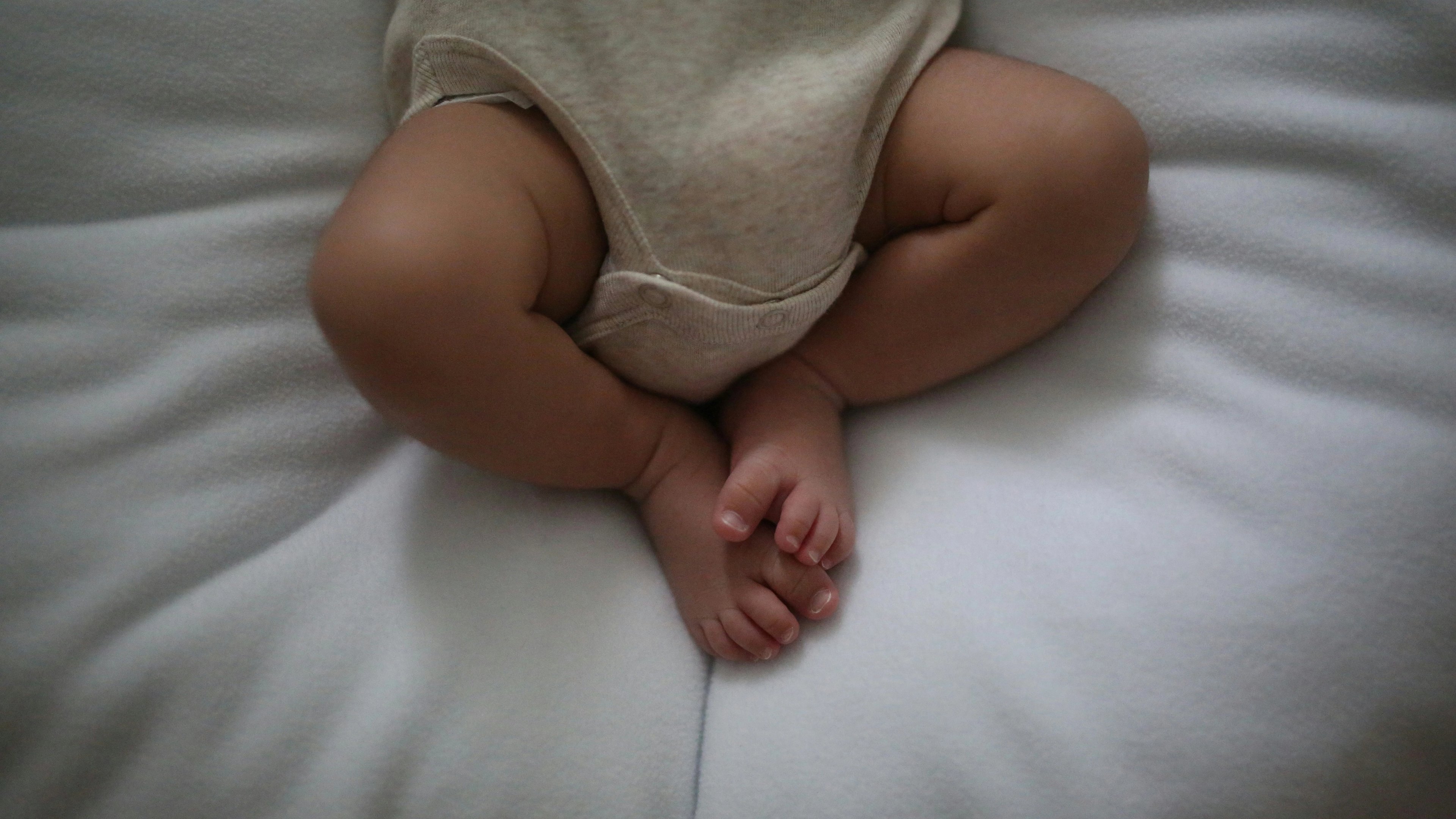
Helping a newborn fall asleep — and stay asleep — can often feel like a real challenge for new parents. Fortunately, there are several proven strategies that can make a big difference. We've gathered some of the best evidence-based tips to help you create a healthy sleep routine and give your baby the best possible start toward restful, consistent sleep.
Pre-Sleep Routines: Establish a calm, consistent bedtime routine. For example, studies show that infants given the same nightly routine (bath → massage or lotion → story/quiet time) fell asleep faster and woke less at night pmc.ncbi.nlm.nih.gov. Children’s hospitals recommend 20–30 minutes of “quiet time” (reading or soft music) before lights out, followed by simple steps (diaper change, lullaby) chop.edu. The baby should be put into the crib drowsy but awake, so they learn to self-soothe healthychildren.orgstanfordchildrens.org. A calm environment helps: dim the lights and keep noise low, and avoid stimulating activities after dinner. (For newborns, follow day–night cues: keep daytime active and feed/play often to help nighttime sleep healthychildren.org.)
- Consistent timing: Go to bed at the same time every night. A regular schedule teaches circadian rhythm and reduces overtiredness. (Older infants typically do best with a slightly earlier bedtime; staying up late can backfire.)
- Warm bath and gentle massage: A warm bath can relax baby. Follow with a short massage or applying baby lotion (as in one study, a nightly 15-min infant massage significantly shortened time to fall asleep and reduced night wakings ssrn.com). Keep strokes gentle and fuss-free.
- Soothing sounds: Many babies respond well to white noise or soft lullabies. In one classic study, 80% of newborns fell asleep within 5 minutes of hearing white noise healthline.com. You can use a white-noise machine or a fan, but keep volume at a safe, moderate level. (Experts warn that very loud or continuous noise can harm hearing or create dependency healthline.com, so use it judiciously.)
- Drowsy-put-down: Place the baby in the crib before they are fully asleep. This helps them associate the crib with falling asleep. Avoid rocking or feeding until the baby is deeply asleep, or they may struggle to resettle during the night healthychildren.orgstanfordchildrens.org. For example, a responsive parenting trial found babies whose bedtime routines avoided feeding immediately before lights-out were more likely to self-soothe and sleep better pmc.ncbi.nlm.nih.gov.
- Avoid overstimulation: Turn off screens (no screens for babies) and keep chatter soft. Speak in hushed tones and move calmly. CHOP Pediatric Sleep experts advise finishing the bedtime routine by saying “goodnight,” turning out the lights, and leaving the room chop.edu. (This clear “end of routine” cue signals it’s sleep time.)
Getting to Sleep – Techniques: When it’s time to fall asleep, gentle soothing can help. Rocking or swaying in dim light can settle a newborn. Using a pacifier at bedtime is another common trick – besides soothing, pacifiers are also associated with lower SIDS risk in studies (the AAP recommends offering a pacifier at naps and bedtime). Some parents find “bedside camping” effective: sit beside the crib and softly pat or shush the baby until they quiet down, then slowly reduce contact each night. Importantly, studies show any consistent method works much better than none. For example, one RCT of sleep training (parents responding on a schedule with brief comforting) found that after training, only 4% of infants had persistent severe sleep problems versus 14% with no training pmc.ncbi.nlm.nih.gov. Similarly, a trial of gentle sleep training (gradual check-and-pat) cut the percentage of parents reporting sleep problems by ~30% at five months follow-up npr.org. In short, teaching a baby to fall asleep on their own—even with gentle, reassuring methods—significantly improves sleep for both baby and parents pmc.ncbi.nlm.nih.govnpr.org.
- Controlled comforting: For babies over ~4–6 months, you can try “controlled crying” methods. This might mean waiting a few minutes when they fuss, then briefly returning to pat or comfort without picking up, and gradually lengthening the intervals. Pediatrics experts note that while some parents worry this sounds harsh, modern sleep training is often much gentler than the classic “cry-it-out.” Jodi Mindell (a noted sleep researcher) emphasizes that most interventions use soothing checks, not leaving a baby to cry endlessly npr.org.
- Consistent response: Whatever method you choose, be consistent. If you decide to pause before soothing a wakeful infant, do it calmly: say “You’re okay, it’s night,” pat gently, then wait. Stanford Children’s Health advises if a baby wakes and cries, wait a few minutes, then calmly pat and say “goodnight” before leaving again stanfordchildrens.org. Over successive nights, many babies learn to drift off between checks.
- Avoid immediate dependency: If a baby always falls asleep in a parent’s arms, picking them up at each wakening can create strong sleep associations. To prevent this, try to break the cycle by putting them down awake and reducing rock/feed-to-sleep habits healthychildren.orgstanfordchildrens.org. (For breastfed babies, this may happen naturally as they grow; for bottle-fed, gradually reducing the bottle size at bedtime or offering it before the crib can help chop.edu.)
Staying Asleep Strategies: Once your baby is asleep, create conditions that support uninterrupted sleep:
- Safe, comfortable sleep space: Always place infants on their back on a firm mattress without loose bedding or toys. Keep the room at a comfortable temperature (around 68–72°F) so baby isn’t too hot or cold. The American Academy of Pediatrics also recommends room-sharing (baby sleeps in same room) for the first 6–12 months to reduce SIDS risk pmc.ncbi.nlm.nih.gov, but not bed-sharing. (Even though co-sleeping can make nighttime feeding easier for some parents, AAP guidelines caution that bed-sharing—even on a couch or sofa—has been linked to accidents and SIDS pmc.ncbi.nlm.nih.gov.)
- Consistent daytime naps: Follow an age-appropriate nap schedule. Well-rested babies tend to sleep more soundly at night. For instance, CHOP advises that once newborns have mastered basic feeding, they should have regular naps and not nap too long or too late in the day chop.edu. (By contrast, overtired babies often have more fragmented sleep.)
- Calm night care: If the baby wakes at night, keep lights dim and interactions calm and brief. Change diapers or feed as needed, but avoid stimulating talk or play. Try to let them resettle in the crib; if you must pick them up, do so quietly and return them before fully awake. Again, give a few moments for self-soothing – as AAP notes, it’s normal for an infant (even 6 months old) to wake briefly and fall back asleep on their own healthychildren.org.
- Soothing objects (older infants): When your baby is a bit older (able to roll and sit), a small, safe comfort object (like a lovey or soft toy) can help them drift back to sleep. Stanford experts note that by about 9–12 months, a familiar blanket or stuffed animal can become a helpful “transitional object” at bedtime stanfordchildrens.org.
- Gradual night weaning (when appropriate): Around 6 months or later, most infants can go longer stretches without feeding. Follow your pediatrician’s advice about night-feed schedules. If aiming to reduce night feeds, do it slowly (for example, stretch intervals a little each week). CHOP suggests cutting back bedtime bottles gradually if used chop.edu.
- White noise at night: If white noise helps at bedtime, you can leave a low-volume machine running all night to mask sudden noises. Many parents find a steady hum (like a fan) prevents minor sounds from fully waking the baby. Just remember to watch volume – some experts warn that machines set too loud (above 50–60 dB) can disturb hearing developmenthealthline.com.
Evidence and Considerations: Most of these methods are backed by research. For example, consistent bedtime routines alone have been shown in trials to improve sleep onset and continuity pmc.ncbi.nlm.nih.gov, and parental education/intervention (guidance on normal sleep patterns and routines) significantly increases infants’ consolidated night sleep bmcpediatr.biomedcentral.com. “Sleep training” methods (including gentle check-and-pat) reliably reduce night wakings and improve both baby and parent sleep without long-term harm pmc.ncbi.nlm.nih.govpmc.ncbi.nlm.nih.gov. Indeed, one review noted no adverse effects after 5 years for children who had sleep training pmc.ncbi.nlm.nih.gov.
However, some effective methods do attract criticism. Cry-it-out: Many parents feel uneasy about letting a baby cry, and it’s true that classic “extinction” (ignoring cries completely) can be distressing. Pediatricians note that today’s approaches are often more gradual and responsive than the name suggests npr.org. As one NPR health article puts it, “sleep training has gotten a bad rap because it’s been equated with ‘cry it out,’” but in practice most programs teach parents to check in and comfort the baby at increasing intervals npr.orgnpr.org. Importantly, scientific studies find that even with sleep training, babies experience normal stress responses and no lasting emotional harm; in fact, parent stress and depression often improve when baby sleeps better pmc.ncbi.nlm.nih.govpmc.ncbi.nlm.nih.gov.
White noise/sound machines: While white noise is popular, parents should beware of potential downsides. As Healthline notes, excessive volume or 24/7 use could affect hearing or make a child dependent on noise to sleep healthline.com. Experts suggest using a timer or moderate setting.
Co-sleeping vs crib: Some parents swear by bed-sharing for bonding or easier feeding, but the AAP warns that even “low-risk” bed-sharing can raise SIDS risk. Recent data show that room-sharing (baby in same room, separate surface) is safest pmc.ncbi.nlm.nih.gov. Countries differ in guidelines (some European pediatricians allow bed-sharing with precautions), so weigh the risks and benefits carefully and always follow safe-sleep guidelines (no loose bedding, etc.).
In summary, a loving, predictable routine plus a safe sleep environment are the foundations of good infant sleep. Parents report that consistency and patience are key. Even if progress is gradual, sticking with these strategies usually pays off. If significant sleep problems persist, consult your pediatrician—sometimes there are medical issues (ear infections, reflux) that need attention. But for most families, using the above evidence-backed tips will help baby (and parents!) get more and better sleep.
Sources:
Verified pediatric and sleep-research sources including AAP guidelines and peer-reviewed studies have been used throughout (citations in text). These include randomized trials and expert recommendations supporting bedtime routines pmc.ncbi.nlm.nih.gov, parental educationbmcpediatr.biomedcentral.com, sleep training pmc.ncbi.nlm.nih.gov, and soothing techniques ssrn.comhealthline.com. Each suggested method is drawn from clinical research or authoritative pediatric advice.
Citations
A Nightly Bedtime Routine: Impact on Sleep in Young Children and Maternal Mood - PMC
https://pmc.ncbi.nlm.nih.gov/articles/PMC2675894/
Healthy Sleep Habits | Children's Hospital of Philadelphia
https://www.chop.edu/primary-care/healthy-sleep-habits
Getting Your Baby to Sleep - HealthyChildren.org
https://www.healthychildren.org/English/ages-stages/baby/sleep/Pages/getting-your-baby-to-sleep.aspx
Infant Sleep - Stanford Medicine Children's Health
https://www.stanfordchildrens.org/en/topic/default?id=infant-sleep-90-P02237
Getting Your Baby to Sleep - HealthyChildren.org
https://www.healthychildren.org/English/ages-stages/baby/sleep/Pages/getting-your-baby-to-sleep.aspx
https://www.ssrn.com/abstract=4089086
White Noise for Babies: Pros and Cons
https://www.healthline.com/health/parenting/white-noise-for-babies
White Noise for Babies: Pros and Cons
https://www.healthline.com/health/parenting/white-noise-for-babies
INSIGHT Responsive Parenting Intervention and Infant Sleep - PMC
https://pmc.ncbi.nlm.nih.gov/articles/PMC4925087/
Infant sleep training: rest easy? - PMC
https://pmc.ncbi.nlm.nih.gov/articles/PMC5962992/
Sleep Training Science: Myths And Facts About How To Get Baby To Sleep : Shots - Health News : NPR
Sleep Training Science: Myths And Facts About How To Get Baby To Sleep : Shots - Health News : NPR
Infant Sleep - Stanford Medicine Children's Health
https://www.stanfordchildrens.org/en/topic/default?id=infant-sleep-90-P02237
Infant Sleep - Stanford Medicine Children's Health
https://www.stanfordchildrens.org/en/topic/default?id=infant-sleep-90-P02237
Healthy Sleep Habits | Children's Hospital of Philadelphia
https://www.chop.edu/primary-care/healthy-sleep-habits
Bedsharing may partially explain the reduced risk of sleep-related death in breastfed infants - PMC
https://pmc.ncbi.nlm.nih.gov/articles/PMC9792691/
Healthy Sleep Habits | Children's Hospital of Philadelphia
https://www.chop.edu/primary-care/healthy-sleep-habits
Getting Your Baby to Sleep - HealthyChildren.org
https://www.healthychildren.org/English/ages-stages/baby/sleep/Pages/getting-your-baby-to-sleep.aspx
Infant Sleep - Stanford Medicine Children's Health
https://www.stanfordchildrens.org/en/topic/default?id=infant-sleep-90-P02237
https://bmcpediatr.biomedcentral.com/articles/10.1186/s12887-024-04771-6
Infant sleep training: rest easy? - PMC
https://pmc.ncbi.nlm.nih.gov/articles/PMC5962992/
Sleep Training Science: Myths And Facts About How To Get Baby To Sleep : Shots - Health News : NPR
Sleep Training Science: Myths And Facts About How To Get Baby To Sleep : Shots - Health News : NPR
Emily Rodriguez
Editorial team member at Sleep Now

